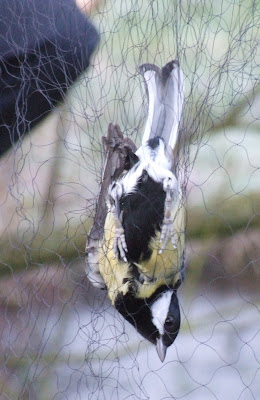Finally after 13 days of wind and rain not only has the weather improved to dry and calm it has also managed to achieve it on a weekend instead of a Monday.
I haven't had any ringing opportunities so far this year as either the weather has been against it or my trainer has been busy, so it was time to go out and have the first picnic of the year. My good lady and I decided to head for West Mainland. We had a brief stop at Skaill Beach to watch a lone canoeist riding the surf, rather him than me. We decided to go to Marwick Bay as there has been quite a few reports over the last week or two of a high number of white gulls appearing in Orkney.
Now gulls are not my best group of birds to ID. Yes I can tell the difference between the common ones as long as they are in adult plumage. Juvenilles just seem to scramble my brain a bit. So the reports of
Iceland and
Glaucous Gulls sent me running to my ID books. ID should be fairly simple neither adult bird would have any black in the plumage, that should make them easy to pick out of the crowd then.
Iceland Gulls would be about the same size as a
Herring Gull and the
Glaucous Gull the same size as a
Great Black-backed Gull.
Iceland Gulls have a small rounded head with a small bill whereas the
Glaucous Gull has a large head with a large bill. Also the
Iceland Gulls wings should extend beyond the tail.
Having got that sorted in my mind there were also reports of
Kumlien's Gull. Now according to my ID book (A Field Guide to the Seabirds of Britain and the World) this bird is a race of
Iceland Gull. Immediately alarm bells start ringing in my head and something told me identifcation was not going to be easy. The book says "Wing quills slightly darker grey than
Iceland Gull and shows grey spots towards white wing tips, but difficult to identify between the two." I knew it.
Then of course there are the juvenilles. The first year birds are described as being buffy in colour with second year birds being a pale cream colour above and below. Both having white primaries.
Having arrived at the car park at Marwick Bay, the first thing we spotted apart from the two surfers were four white gulls sat on the rocks right in front of the car park.
I came to the conclusion that these were
Iceland Gulls since they all had wings extending past the end of their tails and they looked like small head and bill. The only thing that has cast a little doubt in my mind is the bird centre rear who seems to have a noticeably darker grey plumage than the bird in front of it.
We then headed South along the coastal path to the Fishermen's huts, as this was where the carcass of a whale had been reported and that it was providing good feeding for the gulls. As we walked along the path other white gulls could be seen on the rocks and flying past. Not far from the Fishermen's Huts there was a distinct change to the smell of the air going from one of fresh sea air to that of rotting flesh. There were lots of gulls flying around and as we approached the huts the carcass could be seen down on the water's edge.
On the small cliff to the right there were over 50 gulls, three
Greater Black-backed Gulls, three
Herring gulls, a couple of
Common Gulls and the rest white gulls. A single
Fulmar flew past.
These two I think are
Iceland Gulls.
These I think are
Glaucous Gulls.
If I'm wrong I would be happy to be corrected.
After chatting to some of the local birders we headed back to the car park for our picnic. As the tide went out more white gulls could be seen on the beach, along with a couple of
Redshanks, approx 25
Turnstones, a male
Red Breasted Merganser, a female
Eider and a
Rock Pipit.
Having never paid too much attention to gulls that much, these two white gulls were new ones to my life list.
The drive home took us past the Ring of Brodgar and as we passed over the bridge where Harray Loch flows into Stenness Loch I spotted a pair of
Mute Swans with a couple of youngsters. With the sun starting to set toward Hoy I just had to stop and take a few photos.
A nice way to end the day out.













